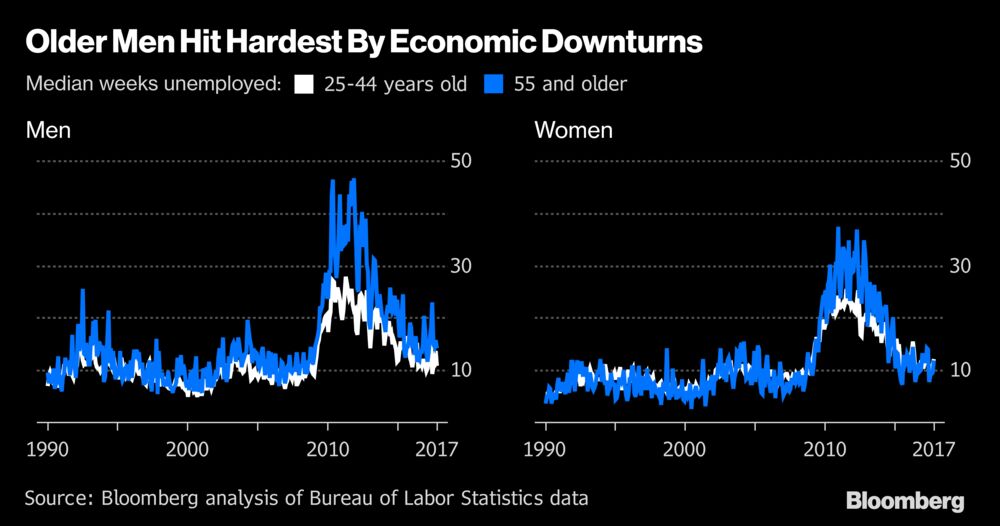Chris McCall was getting ready for the birth of his second daughter in 2013 when the unexpected hit: He was let go after four years at agencyQ, a digital marketing company in Washington.
After a couple of months of looking for a job, and caring for an infant and her two-year-old sister, McCall and his wife, Rebecca, decided he would be a stay-at-home dad. His wife would earn the family paycheck.
A third daughter came in 2015, and McCall, 39, started to worry about his ability to get back into the job market. When he applied, he encountered an obstacle familiar to many workers: a bias against older employees and people with resume gaps.
“I applied to several positions where I was over-qualified and didn’t feel like I got that much consideration,” he says. While some companies understood his child-care hiatus, for others “it was another black mark against me,” he says.
For all the lip service companies give to family-oriented policies and non-discriminatory hiring, economists find evidence of age bias. People who voluntarily step out of the labor market don’t fare well, either.
That might be changing. Federal Reserve Chair Janet Yellen has allowed the labor market to undershoot the jobless rate that the central bank says is consistent with full employment. It was a gamble that the economy would pull in labor from the margins, putting more people to work without stoking unwanted inflation. The strategy is working on both counts.
Experienced workers
Ford Motor Co., Barclays Plc and Booz Allen Hamilton Inc. are just some of the companies now targeting workers with previous experience who for various reasons have been outside the labor force.
Some of these hires come at a bargain. A paper by three Fed researchers and one at Columbia University shows detached workers can cost about 25 percent less than if a firm tried to poach a similar employee from another company.
“It makes sense for firms to go after non-participants,” as they are less likely to set off wage-bidding by seeking counteroffers, says Aysegul Sahin of the New York Fed, one of the paper’s co-authors.

To the surprise of some firms, the quality of applicants is also high. “This is a tremendous pool of talent,” said Barbara Byrne, the New York-based vice chairman of investment banking at Barclays, which this year has received 870 applications for 26 spots in its Encore program aimed at returning workers. “The workplace needs these people to come back in.”
So does the U.S. economy.
Growth hinges on labor supply, which is rising at a slower pace as baby boomers -- the generation born between 1946 and 1964 -- retire.
Back-to-work programs could also heal a disturbing post-recession scar. A significant number of men and women left the labor force and didn’t come back.
Prime age
Some 91.5 percent of men -- and 75.6 percent of women -- 25 to 54 years old, or prime working age, were working or looking for a job at the start of 2007.
Today those numbers are 74.9 percent for women and just 88.5 percent for men, a number Dartmouth College economist and former Yellen adviser Andrew Levin calls “an urgent public policy problem.”

Theories about what happened to the so-called missing men range from opioid addiction to the loss of middle-skill jobs as technology and automation infuse into more tasks.
But McCall’s experiences suggest that bias is also at work. Some managers who suspect it’s there are intent on quashing it.
“My objective is that we shatter stereotypes about gaps in service,” said Holly Rollins, a Colorado-based director of cybersecurity at Booz Allen Hamilton who initiated the firm’s re-engagement program.
Rebecca McCall spotted the program at Booz Allen, where she also works, and told her husband about it. Booz Allen hiring managers embraced the child-care gap, Chris McCall said. His skills were still sharp, and, after a brief internship, he was hired in June 2016, in a unit separate from Rebecca’s.
“I was happy to get back in the labor force,” he said.
Tight markets
Rollins said she didn’t sell the idea to senior management solely as a diversity concept that would benefit women, even though returning stay-at-home mothers are big beneficiaries of such programs.
“We are in very, very tight labor markets,” Rollins said. Reaching out to disengaged, qualified people is “another solution in the toolbox” to meet hiring needs.
Many companies work with Carol Fishman Cohen and her company iRelaunch, which now consults with about 30 large firms -- including International Business Machines Corp. and Morgan Stanley -- on implementation. (Bloomberg LP has occasionally consulted with iRelaunch on programs supporting returning women.)
Cohen, who like Byrne is a mother of four, restarted her career at Bain Capital after an 11-year child-care break.
Low unemployment may be one reason for the rising popularity of the programs, Cohen says. Another is the “caliber of the candidates” participating in so-called returnships, she says.
Ann Haener-Maghran, 55, started working at Ford as an auto interior engineer this year, after about a 20-year absence from the labor force. She completed a six-month internship in the manufacturer’s return-to-work program that began this year.
Employees such as Haener-Maghran, who has an engineering degree and an MBA, “have an abundance of professional experience and are excited to get back to work,” said Meeta Huggins, Ford’s chief diversity officer. “Why not leverage this talent pool?”
Recommended For You
© 2025 ALM Global, LLC, All Rights Reserved. Request academic re-use from www.copyright.com. All other uses, submit a request to [email protected]. For more information visit Asset & Logo Licensing.







